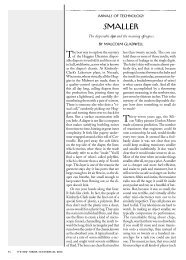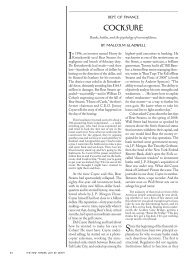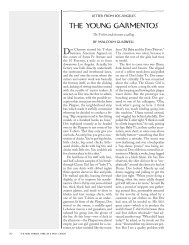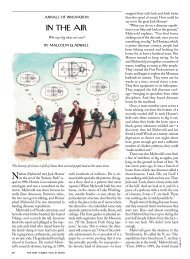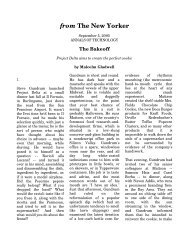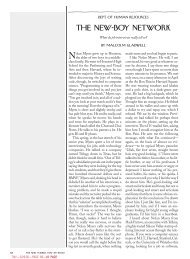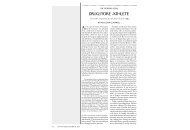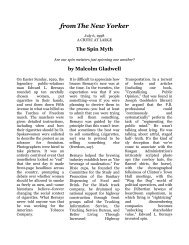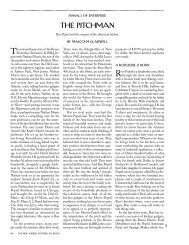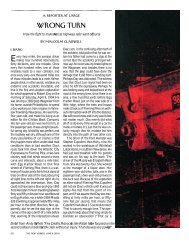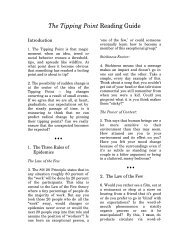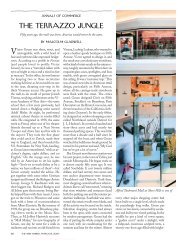DESIGNS FOR WORKING - Malcolm Gladwell
DESIGNS FOR WORKING - Malcolm Gladwell
DESIGNS FOR WORKING - Malcolm Gladwell
Create successful ePaper yourself
Turn your PDF publications into a flip-book with our unique Google optimized e-Paper software.
In the early nineteen-sixties, Jane Jacobs<br />
lived on Hudson St re e t ,in Gre e nw<br />
i ch Vi ll a g e, near the intersection of<br />
Eighth Avenue and Bleecker St re e t .I t<br />
was then, as now, a ch a rming d i s t rict of<br />
n i n e t e e n t h - c e n t u y rtenements<br />
and tow n<br />
h o u s e s ,bars and shops,laid outover an irregular<br />
gri d ,and Jacobs loved the neighb<br />
o rh o o d .In her 1961 masterp i e c e,“T h e<br />
Death and Life of G reat Am e ri can Citi<br />
e s , ”she rh a p s o d i zed about the Wh i t e<br />
Horse Ta ve rn down the block ,h ome to<br />
Irish lon g s h o remen and writers and int<br />
e llectuals—a place where, on a winter’s<br />
n i g h t ,as “the doors open, a solid wave of<br />
c onve r s a t i on and animation surges out<br />
and hits yo u . ”Her Hudson St reet had<br />
M r. Sl u b e, at the cigar store, and Mr.<br />
La c ey, the lock s m i t h , and Bern i e, t h e<br />
ca n d y - s t o re ow n e r, w h o,in the course of<br />
a typ i cal day, s u p e rvised the ch i l d re n<br />
DEPT. OF HUMAN RESOURCES<br />
<strong>DESIGNS</strong> <strong>FOR</strong> <strong>WORKING</strong><br />
Wh y y o u r b o s s e sw a n t t o tu rn y o u r n ew o f fic e i n t oGre e n w i ch Vi l l a ge.<br />
6 0 THE NEW YO R K E R, DECEMBER 11, 2000<br />
BY MALCOLM GLADWELL<br />
c rossing the stre e t , lent an umbre lla or<br />
a d o llar to a custom e r, held on to som e<br />
k eys or packages for people in the neighb<br />
o rh o o d ,and “l e c t u red two yo u n g s t e r s<br />
who asked for cigare t t e s . ”The street had<br />
“b u n dles and pack a g e s ,z i g zagging from<br />
the drug store to the fruit stand and back<br />
over to the butch e r’s , ”a n d “ t e e n a g e r s ,a ll<br />
d ressed up, a re pausing to ask if t h e i r<br />
slips show or their collars look ri g h t . ”I t<br />
w a s ,she said, an urban ball e t .<br />
The mira cle of H u d s on St re e t ,a cc<br />
o rding to Jacobs, was created by the<br />
p a rticular con fig u ra t i on of the stre e t s<br />
and buildings of the neighborh o o d .J acobs<br />
argued that when a neighborh o o d<br />
is oriented tow a rd the stre e t ,when sidewalks<br />
are used for socializing and play<br />
and com m e rc e, the users of that stre e t<br />
a re tra n s f o rmed by the resulting stimul<br />
a t i on :t h ey form re l a t i onships and ca s u a l<br />
c ontacts they would never have otherw<br />
i s e .The West Vi ll a g e,she pointed out,<br />
was blessed with a mixture of h o u s e s<br />
and apartments and shops and offic e s<br />
and industry, w h i ch meant that there<br />
w e re alw ays people “outdoors on diffe rent<br />
schedules and . ..in the place for diffe<br />
rent purp o s e s . ”It had short block s ,a n d<br />
s h o rt blocks create the greatest vari e ty in<br />
foot tra f fic .It had lots of old buildings,<br />
and old buildings have the low rents that<br />
p e rmit individualized and cre a t i ve uses.<br />
An d ,most of a ll ,it had people,cheek by<br />
j ow l ,f rom eve ry conceivable walk of l i fe .<br />
Sp a re ly populated suburbs may look app<br />
e a l i n g, she said, but without an act<br />
i ve sidewalk life, without the fre q u e n t ,<br />
s e rendipitous intera c t i ons of m a ny diffe<br />
rent people, “ t h e re is no public acq<br />
u a i n t a n c e s h i p,no foundation of p u b l i c<br />
t ru s t ,no cro s s - c on n e c t i ons with the nece<br />
s s a ry people—and no practice or ease<br />
in applying the most ord i n a ry techniques<br />
of c i ty public life at low ly leve l s . ”<br />
Jane Jacobs did not win the battle she<br />
set out to fig h t .The West Vi llage re m a i n s<br />
an anom a ly.Most developers did not want<br />
to build the kind of c om mu n i ty Jacobs<br />
talked about,and most Am e ri cans didn’t<br />
want to live in on e .To re read “Death and<br />
L i fe” t o d ay, h ow eve r, is to be stru ck by<br />
h ow the intervening years have given her<br />
arguments a new and unexpected re l ev<br />
a n c e .Wh o,a fter all ,has a direct intere s t<br />
in creating dive r s e, vital spaces that foster<br />
cre a t i v i ty and sere n d i p i ty? Employ -<br />
ers do. On the fortieth annive r s a ry of i t s<br />
p u b l i ca t i on ,“Death and Life” has been<br />
re b o rn as a primer on workplace design.<br />
The para llels between neighborh o o d s<br />
and offices are stri k i n g.T h e re was a time,<br />
for instance, when companies put their<br />
most valued employees in palatial offic<br />
e s, with potted plants in the corn e r,<br />
and secre t a ries out fron t ,g u a rding access.<br />
Those offices were suburbs—gated commu<br />
n i t i e s ,in fact—and many com p a n i e s<br />
came to re a l i ze that if their best employees<br />
were isolated in suburbs they would<br />
be depri ved of public acquaintanceship,<br />
the foundations of public tru s t ,and cro s sc<br />
on n e c t i ons with the necessary people.<br />
In the eighties and early nineties, t h e<br />
f a s h i on in corp o rate Am e ri ca was to foll<br />
ow what designers ca lled “u n i ve r s a l<br />
p l a n n i n g” — rows of i d e n t i cal cubicl e s ,<br />
w h i ch resembled nothing so mu ch as a<br />
Lev i t t ow n .To d ay, u n i versal planning has<br />
f a llen out of f a v o r, for the same re a s on
6 2 THE NEW YO R K E R, DECEMBER 11, 2000<br />
“Life isn’t fair, M i l f o rd, and that’s what makes it fun.”<br />
that the postwar suburbs like Lev i t t ow n<br />
d i d :to thri ve,an office space must have a<br />
di ve r s i ty of uses—it must have the workplace<br />
equivalent of houses and apartments<br />
and shops and industry.<br />
I f you visit the tech n o l o gy com p a n i e s<br />
o f Si l i c on Va ll ey,or the media com p a n i e s<br />
o f M a n h a t t a n ,or any of the firms that<br />
s e l f - c on s c i o u s y lidentify<br />
themselves with<br />
the New Econ om y, yo u’ll find that secluded<br />
private offices have been re p l a c e d<br />
by busy public spaces, open-plan are a s<br />
without wall s , e xe c u t i ves next to the<br />
n ewest hire s .The hush of the tra d i t i on a l<br />
o f fice has been supplanted by som e t h i n g<br />
mu ch closer to the noisy,bustling ballet of<br />
H u d s on St re e t .Fo rty years ago, p e o p l e<br />
l i ved in neighborhoods like the West Vi llage<br />
and went to work in the equivalent of<br />
s u b u rb s .Now, in one of the odd reve r s a l s<br />
that mark the current econ om y, t h ey live<br />
in suburbs and,i n c re a s i n g y,go l to work in<br />
the equivalent of the West Vi ll a g e .<br />
The office used to be imagined as a<br />
place where employees punch cl o ck s<br />
and bosses roam the halls like highs<br />
chool pri n c i p a l s ,l o oking for miscre a n t s .<br />
But when employees sit chained to their<br />
d e s k s , q u i e t ly and industri o u s ly go i n g<br />
about their business,an office is not func<br />
t i oning as it should. T h a t’s because inn<br />
ov a t i on—the heart of the know l e d g e<br />
e c on omy—is fundamentally social.I d e a s<br />
a rise as mu ch out of casual conve r s a t i on s<br />
as they do out of f o rmal meetings.M o re<br />
p re c i s e ly, as one study after another has<br />
d e m on s t ra t e d the , best ideas in any workplace<br />
arise out of casual contacts amon g<br />
d i f fe rent groups within the same comp<br />
a ny. I f you are designing widgets for<br />
Ac m e . c om,for instance,it is unlikely that<br />
a bre a k t h rough idea is going to come<br />
• •<br />
f rom som e one else on the widget team:<br />
a fter all , the other team members are as<br />
b l i n k e red by the day - t o - d ay demands of<br />
dealing with the existing product as yo u<br />
a re .Som e one from outside Ac m e . c om —<br />
your old engineering pro fe s s o r, or a guy<br />
you used to work with at Ap e x . c om —<br />
i s n’t going to be that helpful, e i t h e r. A<br />
p e r s on like that doesn’t know enough<br />
about Ac m e’s widgets to have a tru ly<br />
useful idea.The most useful insights are<br />
l i k e ly to come from som e one in custom e r<br />
s e rv i c e,who hears firsthand what widget<br />
c u s t omers have to say, or from som e on e<br />
in mark e t i n g,who has wrestled with the<br />
p roblem of h ow to explain widgets to<br />
n ew users,or from som e one who used to<br />
w o rk on widgets a few years back and<br />
whose work on another Acme pro d u c t<br />
has given him a fresh perspective .I n n ov<br />
a t i on comes from the intera c t i ons of<br />
people at a com f o rtable distance from<br />
one another, neither too close nor too far.<br />
This is why—quite apart from the matter<br />
of logistics and effic i e n cy — c om p a n si<br />
e<br />
h a ve offices to begin with. T h ey go to<br />
the trouble of g a t h e ring their employe e s<br />
under one ro o f b e cause they want the<br />
widget designers to bump into the people<br />
in marketing and the people in cust<br />
omer service and the guy who moved to<br />
another depart m e n t a few years back .<br />
The ca t ch is that getting people in an<br />
o f fice to bump into people from another<br />
d e p a rtment is not so easy as it look s .I n<br />
the sixties and seve n t i e s ,a re s e a rcher at<br />
M . I . T. named T h omas Allen con d u c t e d<br />
a deca d e - l ong study of the way in which<br />
engineers com mu n i cated in re s e a rch -<br />
a n d - d eve l o pment labora t o ri e s . A ll e n<br />
found that the likelihood that any tw o<br />
people will com mu n i cate drops off d ram<br />
a t i ca ly as the distance between their
6 4 THE NEW YO R K E R, DECEMBER 11, 2000<br />
desks incre a s e s :we are four times as likely<br />
to com mu n i cate with som e one who sits<br />
six feet away from us as we are with someone<br />
who sits sixty feet away. And people<br />
seated more than seve n ty - five feet apart<br />
h a rdly talk at all .<br />
A ll e n’s second finding was even more<br />
d i s t u rb i n g. When the engineers were n’t<br />
talking to those in their immediate vicini<br />
ty, m a ny of t h e mspent their time talking<br />
to people o u t s i d etheir com p a ny — t o<br />
their old computer-science pro fessor or<br />
the guy they used to work with at Ap p l e .<br />
He con cluded that it was actually easier to<br />
make the outside ca ll than to walk acro s s<br />
the ro om .I f you con s t a n t ly ask for advice<br />
or guidance from people inside your org<br />
a n i za t i on ,a fter all ,you risk losing pre st<br />
i g e .Your colleagues might think you are<br />
i n c om p e t e n t .The people you keep a s king<br />
for advice might get annoyed at yo u .<br />
C a lling an outsider avoids these pro bl<br />
e m s .“The engineer can easily excuse his<br />
l a ck of k n owledge by pretending to be<br />
an ‘e x p e rt in something else’ who needs<br />
s ome help in ‘b roadening into this new<br />
a re a , ’” A llen wro t e .He did his study in<br />
the days before E-mail and the Intern e t ,<br />
but the advent of digital com mu n i ca t i on<br />
has made these problems worse. A ll e n’s<br />
engineers were far too willing to go outside<br />
the com p a ny for advice and new<br />
i d e a s .E-mail makes it even easier to talk<br />
to people outside the com p a ny.<br />
The task of the offic e, t h e n ,is to i nvite<br />
a particular kind of social intera ct<br />
i on—the ca s u a l , n on t h reatening encounter<br />
that makes it easy for re l a t i ve<br />
s t rangers to talk to each other. O f fic e s<br />
need the sort of social milieu that Jane<br />
Jacobs found on the sidewalks of t h e<br />
West Vi ll a g e .“It is possible in a city stre e t<br />
n e i g h b o rhood to know all kinds of p e ople<br />
without unw e l c ome entanglements,<br />
without bore d om ,n e c e s s i ty for exc u s e s ,<br />
e x p l a n a t i on s fears , of giving offe n s e,e mb<br />
a r rassments respecting impositions or<br />
c om m i t m e n t s ,and all such para ph e rn alia<br />
of o b l i g a t i ons which can accom p a ny<br />
less limited re l a t i on s h i p s , ”Jacobs wro t e .<br />
I f you substitute “o f fic e” for “c i ty stre e t<br />
n e i g h b o rh o o d , ”that sentence becom e s<br />
the perfect statement of what the mode<br />
rn employer wants from the work p l a c e .<br />
Imagine a classic big-city office tow e r,<br />
with a floor plate of a hundred and<br />
e i g h ty feet by a hundred and eighty fe e t .<br />
The center part of eve ry floor is give n
over to the guts of the building: e l ev at<br />
o r s , b a t h ro om s ,e l e c t ri cal and plumbing<br />
sys t e m s .A round the core are cubicles<br />
and interior offic e s ,for support staff<br />
and lower management.And around the<br />
edges of the flo o r, against the window s ,<br />
a re rows of o f fices for senior staff, e a ch<br />
ro om perhaps two hundred or two hund<br />
red and fifty square fe e t .The best res<br />
e a rch about office com mu n i ca t i on tell s<br />
us that there is almost no worse way to<br />
l ay out an offic e . The exe c u t i ve in on e<br />
c o rner office will seldom bump into any<br />
other exe c u t i ve in a corner offic e .I n d e e d,<br />
s t ringing the exterior offices out alon g<br />
the window s g u a rantees that there will<br />
be ve ry few people within the cri t i ca l<br />
s i x ty-foot radius of those offic e s .To maxi<br />
m i ze the amount of c ontact among emp<br />
l oye e s ,you re a lly ought to put the most<br />
valuable staff members in the center of<br />
the ro om ,w h e re the highest number of<br />
people can be within their orb i t .O r,eve n<br />
b e t t e r, put all places where people tend<br />
to con g re g a t e—the public areas—in the<br />
c e n t e r, so they can draw from as many<br />
d i s p a rate parts of the com p a ny as possib<br />
l e .Is it any wonder that cre a t i ve firm s<br />
o ften pre fer loft - s tyle buildings, w h i ch<br />
h a ve usable centers?<br />
Another way to increase com mu n i cat<br />
i on is to have as few private offices as<br />
p o s s i b l e. The idea is to exchange pri -<br />
vate space for public space, just as in the<br />
West Vi ll a g e, w h e re residents agree to<br />
l i ve in tiny apartments in exchange for a<br />
wealth of n e a rby cafés and stores and<br />
bars and park s. The West Vi ll a g ef o rc e s<br />
its residents outdoors. Few people, f o r<br />
e x a m p l e, h a ve a washer and dryer in<br />
their apart m e n t ,and so even laundry is<br />
n e c e s s a ri ly a social eve n t : you have to<br />
take your clothes to the laundromat dow n<br />
the stre e t . In the office equivalent, d esigners<br />
force employees to move aro u n d ,<br />
t o o.T h ey build in “f u n c t i onal ineffic i e nc<br />
i e s ” ;t h ey put kitchens and copiers and<br />
p rinters and libra ries in places that ca n<br />
be re a ched on ly by a circuitous journ ey.<br />
A m o re direct appro a ch is to create an<br />
o f fice so flexible that the kinds of p e o p l e<br />
who need to spon t a n e o u s ly interact ca n<br />
a c t u a lly be brought together. For e x -<br />
a m p l e, the Fo rd Motor Com p a ny, a l ong<br />
with a group of re s e a rchers from the<br />
U n i ve r s i ty of M i ch i g a n ,re c e n t ly conducted<br />
a pilot project on the effe c t i ve n e s s<br />
o f “war ro om s ”in softw a re deve l o pm e n t .<br />
Prev i o u s ly, s om e one inside the com p a ny<br />
who needed a new piece of s o ftw a re<br />
written would have a series of m e e t i n g s<br />
with the com p a ny’s pro g ra m m e r s ,a n d<br />
the client and the pro g rammers would<br />
send messages back and fort h . In th e<br />
w a r - ro om study,the com p a ny move dt h e<br />
cl i e n t ,the pro g ra m m e r s ,and a manager<br />
into a dedicated con fe rence ro om ,a n d<br />
made them stay there until the pro j e c t<br />
was don e . Using the war ro om cut the<br />
s o ftw a re - d eve l o pment time by tw o -<br />
t h i rd s ,in part because there was far less<br />
time wasted on formal meetings or ca ll s<br />
outside the building: the people who<br />
ought to have been bumping into each<br />
other were now sitting next to each other.<br />
Two years ago,the adve rtising agency<br />
T BWA \ C h i a t \ D ay moved into new offices<br />
in Los An g e l e s ,out near the airp<br />
o rt . In the preceding ye a r s , the firm<br />
had been engaged in a ra d i ca l ,and in<br />
s ome ways disastro u s ,e x p e riment with a<br />
“n on t e r ri t o ri a ”o l f fic e :no one had a desk<br />
or any office equipment of his ow n . I t<br />
was a scheme that courted failure by neglecting<br />
all the ways in which an office is<br />
a sort of n e i g h b o rh o o d .By con t ra s t ,t h e<br />
n ew office is an almost p e rfect embodiment<br />
of Jacobsian principles of c ommu<br />
n i ty. The agency is in a huge old<br />
w a re h o u s e, t h ree stories high and the<br />
s i ze of t h ree footb a ll fie l d s .It is inform<br />
a lly known as Ad ve rtising City, a n d<br />
t h a t’s what it is: a kind of a rt f u ly cons<br />
t ructed urban neighborh o o d .The flo o r<br />
is bisected by a central corridor ca ll e d<br />
Main St re e t ,and in the center of t h e<br />
ro om is an open space, with café tables<br />
and a stand of ficus tre e s ,ca lled Centra l<br />
Pa rk .T h e re’s a basketb a ll court , a game<br />
ro om ,and a bar. Most of the employe e s<br />
a re in snug work s t a t i ons known as nests,<br />
and the nests are grouped together in<br />
n e i g h b o rhoods that radiate from Main<br />
St reet like Pa ris arron d i s s e m e n t s .T h e<br />
top exe c u t i ves are situated in the middl e<br />
o f the ro om .The desk belonging to the<br />
ch a i rman and cre a t i ve director of t h e<br />
c om p a ny looks out on Central Pa rk .T h e<br />
o f fices of the ch i e f financial officer and<br />
the media director abut the basketb a ll<br />
c o u rt .Sp rinkled throughout the building<br />
are meeting ro oms and project are a s<br />
and plenty of n o oks where employe e s<br />
can closet themselves when they need to.<br />
A small part of the building is elev a t e d<br />
a b ove the main floor on a mez za n i n e,<br />
and if you stand there and w a t ch the<br />
people wander about with their port a b l e<br />
ph on e s ,and sit and chat in Central Pa rk ,<br />
and play basketb a ll in the gym ,and you<br />
feel on your shoulders the sun from the<br />
s k ylights and listen to the gentle buzz<br />
o f human activity, it is quite possible to<br />
forget that you are looking at an offic e .<br />
In “The Death and Life of G re a t<br />
Am e ri can Cities,”Jacobs wrote of t h e<br />
i m p o rtance of what she ca lled “p u b l i c<br />
ch a racters”—people who have the so-<br />
“T h ey’re bred for their facial ch a rac teri s t i c s . ”
6 8 THE NEW YO R K E R, DECEMBER 11, 2000<br />
cial position and skills to orch e s t rate the<br />
m ovement of i n f o rm a t i on and the crea<br />
t i on of b onds of t ru s t :<br />
A public character is anyone who is in frequent<br />
contact with a wide circle of people<br />
and who is sufficiently interested to make<br />
himself a public character. . . . The director of<br />
a settlement on New Yo r k ’s Lower East Side,<br />
as an example, makes a regular round of<br />
s t o res. He learns from the cleaner who does<br />
his suits about the presence of dope pushers<br />
in the neighborhood. He learns from the grocer<br />
that the Dragons are working up to something<br />
and need attention. He learns from the<br />
candy store that two girls are agitating the<br />
S p o rtsmen toward a rumble. One of his most<br />
i m p o rtant information spots is an unused<br />
b readbox on Rivington Stre e t .. . . A message<br />
spoken there for any teen-ager within many<br />
blocks will reach his ears unerringly and surprisingly<br />
quickly, and the opposite flow along<br />
the grapevine similarly brings news quickly in<br />
to the bre a d b o x .<br />
A vital com mu n i ty, in Jacobs’s view,<br />
re q u i red more than the appro p ri a t e<br />
phys i cal env i ron m e n t .It also re q u i red a<br />
c e rtain kind of p e r s on ,who could bind<br />
together the vari e d elements of s t re e t<br />
l i fe .O f fices are no diffe re n t .In fact, a s<br />
o f fice designers have attempted to cre a t e<br />
m o re vital work p l a c e s ,t h ey have becom e<br />
i n c re a s i n g y linterested<br />
in identifying and<br />
e n c o u raging public ch a ra c t e r s .<br />
One of the pioneers in this way of<br />
a n a lyzing offices is Ka ren St e ph e n s on ,a<br />
b u s i n e s s - s chool pro fessor and anthropologist<br />
who runs a New Yo rk - b a s e d<br />
c onsulting com p a ny ca lled Ne t f o rm .<br />
St e ph e n s on studies social netw o rk s .Sh e<br />
goes into a com p a ny—her clients incl u d e<br />
J. P.M o r g a n ,the Los Angeles Police Dep<br />
a rt m e n t ,T. R. W. ,and I.B.M.—and dist<br />
ributes a question n a i re to its employe e s ,<br />
a s k i n g about which people they have<br />
c ontact with.Wh om do you like to spend<br />
time with? Wh om do you talk to about<br />
n ew ideas? Wh e re do you go to get exp<br />
e rt advice? Eve ry name in the com p a ny<br />
b e c omes a dot on a gra ph ,and St e ph e ns<br />
on draws lines between all those who<br />
h a ve regular contact with each other.<br />
St e ph e n s on likens her gra phs to X-rays ,<br />
and her role to that of a ra d i o l o g i s t .Wh a t<br />
s h e’s depicting is the firm’s invisible inner<br />
mech a n i s m s ,the re l a t i onships and<br />
n e tw o rks and patterns of t rust that arise<br />
as people work together over time, and<br />
that are hidden beneath the organiza t i on<br />
ch a rt .O n c e,for example,St e ph e n s on was<br />
doing an “X - ray ”o f a Head St a rt organ<br />
i za t i on .The agency was mostly fe m a l e,<br />
and when St e ph e n s on analyzed her net-<br />
w o rks she found that new hires and male<br />
s t a f fers were pro f o u n dly isolated, c ommu<br />
n i cating with the rest of the organizat<br />
i on through on ly a handful of w om e n .<br />
“I looked at tenure in the organiza t i on ,<br />
o f fice ties, d e m o g ra phic data. I couldn’t<br />
see what tied the women together, a n d<br />
w hy the men were talking on ly to these<br />
w om e n , ”St e ph e n s on re ca ll s .“Nor could<br />
the president of the organiza t i on .Sh e<br />
g a ve me a couple of i d e a s . She said,<br />
‘ So r ry I ca n’t fig u re it out.’ Fi n a lly, s h e<br />
asked me to read the names again, and I<br />
could hear her stop, and she said, ‘M y<br />
G o d ,I know what it is.A ll those wom e n<br />
a re smok e r s .’ ” The X-ray revealed that<br />
the men—locked out of the form a l<br />
p ower stru c t u re of the organiza t i on —<br />
w e re trying to gain access and influ e n c e<br />
by hanging out in the smoking area with<br />
s ome of the more senior wom e n .<br />
What St e ph e n s on’s X-rays do best,<br />
t h o u g h ,is tell you who the public ch a racters<br />
are . In eve ry netw o rk , t h e re are<br />
a lw ays one or two people who have conn<br />
e c t i ons to many more people than anyone<br />
else. St e ph e n s on ca lls them “h u b s , ”<br />
and on her ch a rts lines radiate out from<br />
them like spokes on a wheel. ( B e rnie the<br />
ca n d y - s t o re ow n e r, on Jacobs’s Hudson<br />
St re e t ,was a hub.) A few people are also<br />
what St e ph e n s on ca lls “g a t e k e e p e r s ” :<br />
t h ey con t rol access to cri t i cal people, a n d<br />
link together a strategic few dispara t e<br />
g ro u p s .Fi n a ly,i f you analyze the gra ph s<br />
t h e re are alw ays people who seem to<br />
h a ve lots of i n d i rect links to other peop<br />
l e—who are part of a ll sorts of n e tw<br />
o rks without necessari ly being in the<br />
center of t h e m .St e ph e n s on ca lls those<br />
people “p u l s e t a k e r s . ” (In Si l i c on Va ll<br />
eys p e a k ,the person in a sea of c u b i cl e s<br />
who pops his or her head up over the<br />
p a rt i t i on eve ry time something intere s ting<br />
is going on is ca lled a pra i rie dog:<br />
p ra i rie dogs are pulsetakers.)<br />
In the past ye a r, St e ph e n s on has emb<br />
a rked on a partnership with St e e lca<br />
s e, the worl d’s largest manufacturer<br />
o f o f fice furn i t u re, in order to use her<br />
t e chniques in the design of o f fic e s .Trad<br />
i t i on a lly, o f fice designers would tell<br />
a com p a ny what furn i t u re should go<br />
w h e re .St e ph e n s on and her partners at<br />
St e e l case propose to tell a com p a ny what<br />
people should go where, t o o. At St e e lca<br />
s e, t h ey ca ll this “flo o r - ca s t i n g. ”<br />
One of the first projects for the gro u p
is the exe c u t i ve level at St e e l ca s e’s headq<br />
u a rt e r s ,a five - s t o ry building in Gra n d<br />
Ra p i d s ,M i ch i g a n .The exe c u t i ve leve l ,<br />
on the fourth flo o r, is a large,open ro om<br />
filled with small work s t a t i on s . ( Ji m<br />
H a ck e t t ,the head of the com p a ny, o ccupies<br />
what St e e l case ca lls a Pe r s on a l<br />
H a rb o r, a black , f reestanding metal<br />
module that may be—at seven feet by<br />
eight—the smallest office of a Fo rt u n e<br />
500 C.E.O.) One aft e rn o on re c e n t ly,<br />
St e ph e n s on pulled out a laptop and<br />
d e m on s t ra t e dh ow she had mapped the<br />
c om mu n i ca t i on netw o rks of the leadership<br />
group onto a seating ch a rt of t h e<br />
f o u rth flo o r. The dots and swirls are<br />
s t ra n g e ly com p e ll i n g — a b s t ract re p res<br />
e n t a t i ons of s omething real and immed<br />
i a t e .One exe c u t i ve, close to Hack e t t ,<br />
was inundated with lines from eve ry dire<br />
c t i on .“H e’s a hub, a gatekeeper, and a<br />
pulsetaker across all sorts of d i f fe rent dim<br />
e n s i on s , ”St e ph e n s on said.“What that<br />
t e lls you is that he is ve ry stra t e g i c .I f<br />
t h e re is no succession planning aro u n d<br />
that person ,you have got a huge risk to<br />
the knowledge base of this com p a ny. I f<br />
h e’s in a plane accident, t h e re goes yo u r<br />
k n ow l e d g e . ”She pointed to another part<br />
o f the floor plan, with its own thick<br />
ove rl ay of l i n e s .“T h a t’s sales and mark<br />
e t i n g.T h ey have a pocket of real innov<br />
a t i on here .The guy who runs it is ve ry<br />
go o d ,ve ry smart . ”But then she pointed<br />
to the lines connecting that depart m e n t<br />
with other depart m e n t s . “T h ey’re all<br />
c oming into this one place, ” she said,<br />
and she showed how all the lines com i n g<br />
out of m a rketing converged on one senior<br />
exe c u t i ve .“T h e re’s ve ry little path<br />
re d u n d a n cy. In human sys t e m s , yo u<br />
need re d u n d a n cy, you need com mu n i cat<br />
i on across multiple paths.” What conc<br />
e rned St e ph e n s on wasn’t just the lack of<br />
re d u n d a n cy but the fact that, in her<br />
l i n go, m a ny of the paths were “u n c onfirm<br />
e d” :t h ey went on ly one way.Pe o p l e<br />
in marketing were saying that they commu<br />
n i cated with the senior management,<br />
but there were n’t as many lines going<br />
in the other dire c t i on .The sales-andm<br />
a rketing team, she explained, h a d<br />
s om e h ow become isolated from senior<br />
m a n a g e m e n t . T h ey couldn’t get their<br />
voices heard when it came to innov at<br />
i on—and that fact,she said, ought to be<br />
a big con s i d e ra t i on when it comes time<br />
to redo the offic e .“I f you ask the guy who<br />
heads sales and marketing who he wants<br />
to sit next to,h e’ll pick out all the people<br />
he tru s t s , ”she said. “But do you sit him<br />
with those people? No. What you want<br />
to do is put people who don’t trust each<br />
other near each other. Not necessari ly<br />
next to each other, b e cause they get too<br />
cl o s e .But close enough so that when yo u<br />
pop your head up, you get to see people,<br />
t h ey are in your path,and all of a sudden<br />
you build an inviting space where they<br />
can hang out, k i t chens and things like<br />
t h a t .M aybe they need to take a hub in<br />
an innov a t i on netw o rk and place the<br />
p e r s on with a pulsetaker in an expert<br />
n e tw o rk—to get that knowledge indire<br />
c t ly com mu n i cated to a lot of p e o p l e . ”<br />
The work of t ranslating St e ph e n s on’s<br />
insights onto a new floor plan is being<br />
done in a small con fe rence ro om — a<br />
THE NEW YO R K E R, DECEMBER 11, 2000 6 9
7 0 THE NEW YO R K E R, DECEMBER 11, 2000<br />
war ro om — on the second floor of St e e lcase<br />
h e a d q u a rt e r s .The group consists of<br />
a few k ey people from diffe rent parts of<br />
the firm , s u ch as human re s o u rc e s ,d es<br />
i g n ,t e ch n o l o gy, and space-planning res<br />
e a rch. The walls of the ro om are cl u tt<br />
e red with diagrams and pictures and<br />
ca l c u l a t i ons and huge, b l ownup ve r s i on s<br />
o f St e ph e n s on’s X-rays .Team members<br />
s t ress that what they are doing is experim<br />
e n t a l .T h ey don’t know yet how dire<br />
c t ly they want to translate fin d i n g s<br />
f rom the com mu n i ca t i ons netw o rks to<br />
o f fice plans. A fter all , you don’t want to<br />
h a ve to redo the entire office eve ry time<br />
s om e one leaves or joins the com p a ny.<br />
But it’s clear that there are some ve ry<br />
simple principles from the study of p u blic<br />
ch a racters which ought to dri ve the<br />
design pro c e s s .“You want to place hubs<br />
at the center, ” J oyce Brom b e r g, the director<br />
of space planning, s ays . “T h e s e<br />
a re the ones other people go to in ord e r<br />
to get inform a t i on .G i ve them an env ironment<br />
that all ows access. But there<br />
a re also going to be times that they need<br />
to have con t rol—so give them a place<br />
w h e re they can get away. G a t e k e e p e r s<br />
re p resent the fit between gro u p s .T h ey<br />
t ransmit ideas. T h ey are brok e r s ,so yo u<br />
might want to put them at the peri m e t e r,<br />
and give them front porch e s ” — a reas adjoining<br />
the workspace where you might<br />
p u t little tables and ch a i r s. “M aybe they<br />
could have swinging doors with white<br />
b o a rd s ,to better transmit inform a t i on .<br />
As for pulsetakers, t h ey are the ro a m -<br />
e r s . Rather than give them one fixe d<br />
w o rk loca t i on ,you might give them a series<br />
of t o u ch d own spots—where yo u<br />
want them to stop and talk.You want to<br />
enable their meanderi n g. ”<br />
One of the other team members was<br />
a tall ,thoughtful man named Frank Graz<br />
i a n o. He had a series of pencil dra wings—with<br />
circles re p resenting work s t at<br />
i ons of a ll the people whose minds,as he<br />
put it, he wanted to make “e x p l i c i t . ”H e<br />
said that he had done the plan the night<br />
b e f o re .“I think we can thread innov a t i on<br />
t h rough the flo o r, ”he went on ,and with<br />
a pen drew a red line that wound its way<br />
t h rough the maze of d e s k s .It was his<br />
H u d s on St re e t .<br />
“ The Death and Life of G reat Am e ri<br />
can Cities” was a con t rove r s i a l<br />
b o ok ,l a r g e ly because there was alw ays<br />
a whiff o f p a t e rnalism in Jacobs’s vi-<br />
s i on of what city life ought to be. C h e lsea—the<br />
neighborhood dire c t ly to the<br />
n o rth of her beloved West Vi ll a g e—<br />
had “m i x t u res and types of b u i l d i n g s<br />
and densities of d w e lling units per<br />
a c re . . . almost identical with those of<br />
G re e nw i ch Vi ll a g e, ”she noted. But its<br />
l on g - p redicted renaissance would neve r<br />
h a p p e n ,she maintained, b e cause of t h e<br />
“b a r riers of l on g, self-isolating block s . ”<br />
She hated Chatham Vi ll a g e, a planned<br />
“g a rden city ”d eve l o pment in Pi t t s b u r g h .<br />
It was a picturesque green encl a ve, but<br />
it suffe re d , in Jacobs’s analys i s , f rom a<br />
l a ck of s i d ewalk life . She wasn’t conc<br />
e rned that some people might not<br />
want an active street life in their neighb<br />
o rh o o d ; that what she saw as the<br />
“s e l f -isolating block s ”o f Chelsea others<br />
would see as a welcome respite from<br />
the bustle of the city, or that Chatham<br />
Vi llage would appeal to some people<br />
p re c i s e ly because one did not encounter<br />
on its sidewalks a “solid wave of c onve rs<br />
a t i on and animation . ” Jacobs felt that<br />
c i ty dwellers belonged in env i ron m e n t s<br />
like the West Vi ll a g e, whether they rea<br />
l i zed it or not.<br />
The new workplace designers are<br />
making the same ca l c u l a t i on ,o fc o u r s e .<br />
The point of the new offices is to<br />
c ompel us to behave and socialize in<br />
w ays that we otherwise would not—<br />
to ove rc ome our initial incl i n a t i on to<br />
be office suburb a n i t e s .B u t , in all the<br />
studies of the new work p l a c e s , t h e<br />
re s e rv a t i ons that employees have about<br />
a more social env i ronment tend to diminish<br />
once they try it. Human behavi<br />
o r, a fter all , is shaped by con t e x t , b u t<br />
h ow it is shaped—and whether we’ll<br />
be happy with the result—we can understand<br />
on ly with experi e n c e . Jane<br />
Jacobs knew the virtues of the We s t<br />
Vi llage because she lived there . Wh a t<br />
she couldn’t know was that her ideas<br />
about com mu n i ty would ultimately<br />
make more sense in the work p l a c e .<br />
From time to time, social critics have<br />
bemoaned the falling rates of c om mun<br />
i ty part i c i p a t i on in Am e ri can life, b u t<br />
t h ey have made the same mistake. T h e<br />
re a s on Am e ri cans are content to bow l<br />
a l one (or, for that matter, not bowl at<br />
a ll) is that, i n c re a s i n g ly, t h ey re c e i ve all<br />
the social support they need—all the<br />
s e rendipitous intera c t i ons that serve to<br />
make them happy and pro d u c t i ve—<br />
f rom nine to five. ♦



